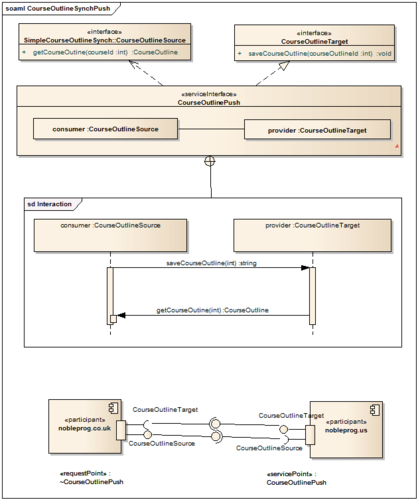SoaML - ServiceInterface
Jump to navigation
Jump to search
UML Collaboration and CollaborationUse
Please see: UML - Collaboration
Modelling Services using ServiceInterface
ServiceInterface:
- Type of a service port
- Can be bi-directional
- Can have a protocol
- Is defined from the perspective of the service provider using three primary sections:
- the provided and required Interfaces (UML interfaces)
- the ServiceInterface class
- the protocol Behavior (activity, sequence or state diagram)
The provided and required Interfaces
- are standard UML interfaces that are realized or used by the ServiceInterface
- The realized interfaces specify
- the value provided
- the messages that will be received by the provider (and correspondingly sent by the consumer)
- The used interfaces define
- the value required
- the messages or events that will be received by the consumer (and correspondingly sent by the provider)
The enclosed parts of the ServiceInterface
- represent the roles that will be played by the connected participants
- the role that is typed by the realized interface will be played by the service provider;
- the role that is typed by the used interface will be played by the consumer.
The Behavior
- specifies the valid interactions between the provider and consumer
- it is the communication protocol of the interaction
- constraining but without specifying how either party implements their role
- any UML behavior specification can be used (interaction and activity diagrams are the most common)
Examples
Instructions
- A ServiceInterface is a UML Class and defines specific roles each participant plays in the service interaction
- These roles have a name and an interface type
- The interface of the provider (which must be the type of one of the parts in the class) is realized (provided) by the ServiceInterface class
- In our example, the OutlineTarget interface is realized by the CourseOutlinePush serviceInterface
- The interface of the consumer (if any) must be used by the class
- In our example, CourseOutlineSource is used by the CourseOutlinePush interface
«ServiceInterface» CourseOutlinePush
- Represents the service
- The terms and conditions under which the service can be enacted and the results of the service
- The service interface may be related to business goals or requirements (we want to 'push' the outline to another site)
- The service interface can also be used in services architectures to show how multiple services and participants work together for a business purpose
- This service interface is defined from the perspective of the provider of the service – the CourseOutlineSource
provider : CourseOutlineTarget
- Defines the role of the provider in the CourseOutlinePush service
- The type of the provider role is “CourseOutlineTarget”
- This is the interface that a provider will require on a port to provide this service.
consumer: CourseOutlineSource
- This is the role of the consumer in the courseOutlinePush service
- The type of the consumer role is “CourseOutlineSource”
- This is the interface that a consumer will implement on a port to consume this service
- In the case of a one-directional service, there may not be a consumer interface
CourseOutlineTarget
- The interface contain all the operations and signals a providing participant may receive when enacting this service
CourseOutlineSource
- The interface for a CourseOutlinePush service consumer
- This indicates all of the operations and signals a consuming participant will receive when enacting the service
- In simple unidirectional services, the consumer interface may be missing or empty.
nobleprog.co.uk
- A participant
- The CourseOutlinePush ServiceInterface is used to type «servicePoint» ports and «requestPoint» ports of participants
- The provider of the service uses a «servicePoint» port and the consumer of the service uses a «requestPoint» port
- Since the 'nobleprog.co.uk' uses a «requestPoint» the “conjugate” interfaces are used – so the nobleprog.co.uk' port provides the CourseOutlineSource interfaces and uses the CourseOutlineTarget interface
- Since they are conjugate, the ports on the nobleprog.co.uk and nobleprog.us can be connected to enact the service
- When «requestPoint» is used the type name will be preceded with a tilde (“~”) to show that the conjugate type is being used
Exercise
- Design a service interface for a PlaceOrderService using example above, use following words:
OrderPlacer, OrderTaker, submitOrder, confirmOrder, rejectOrder, orderProvider, orderConsumer

